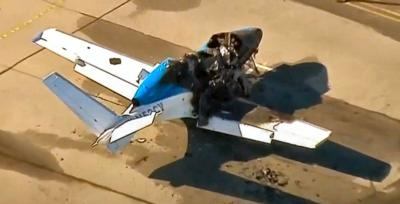Fri, Jun 12, 2020
AD 2020-03-50: This Condition, If Not Addressed, Could Lead To An Uncontained Cabin Fire
The FAA is adopting a new airworthiness directive (AD) for certain Cirrus Design Corporation (Cirrus) Model SF-50 airplanes.

This AD was sent previously as an emergency AD to all known U.S. owners and operators of these airplanes. This AD requires disconnecting and removing the headset amplifier and microphone interface circuit card assemblies for the 3.5 mm audio and microphone jacks. This AD was prompted by a cabin fire incident that occurred on a Cirrus Model SF50 airplane during ground operations where the operator observed smoke exiting from behind the right sidewall interior panel. The FAA is issuing this AD to address the unsafe condition on these products. This AD is effective June 11, 2020 to all persons except those persons to whom it was made immediately effective by Emergency AD 2020-03-50, issued on February 14, 2020, which contained the requirements of this amendment. The Director of the Federal Register approved the incorporation by reference of a certain publication identified in this AD as of June 11, 2020. The FAA must receive comments on this AD by July 27, 2020.
Supplementary Information: On February 14, 2020, the FAA issued Emergency AD 2020-03-05, which requires disconnecting and removing the headset amplifier and microphone interface circuit card assemblies. This emergency AD was sent previously to all known U.S. owners and operators of these airplanes. This action was prompted by a cabin fire incident that occurred on a Cirrus Model SF50 airplane during ground operations. The operator observed smoke exiting from behind the right sidewall interior panel located behind crew seat 2 and forward of passenger seat 5. The investigation into the incident determined the probable root cause was a malfunction of the headset amplifier (part number (P/N) 38849-001) and the microphone interface (P/N 35809-001) circuit card assemblies for the 3.5 millimeter (mm) audio and microphone jacks. This malfunction can result in an electrical short and subsequent uncontained cabin fire without activating circuit protection.
This condition, if not addressed, could lead to an uncontained cabin fire, resulting in possible occupant injury or loss of airplane control.
More News
He Attempted To Restart The Engine Three Times. On The Third Restart Attempt, He Noticed That Flames Were Coming Out From The Right Wing Near The Fuel Cap Analysis: The pilot repor>[...]
Make Sure You NEVER Miss A New Story From Aero-News Network Do you ever feel like you never see posts from a certain person or page on Facebook or Instagram? Here’s how you c>[...]
From 2009 (YouTube Edition): Leading Air Show Performers Give Their Best Advice for Newcomers On December 6th through December 9th, the Paris Las Vegas Hotel hosted over 1,500 air >[...]
Aero Linx: NASA ASRS ASRS captures confidential reports, analyzes the resulting aviation safety data, and disseminates vital information to the aviation community. The ASRS is an i>[...]
“For our inaugural Pylon Racing Seminar in Roswell, we were thrilled to certify 60 pilots across our six closed-course pylon race classes. Not only did this year’s PRS >[...]
 NTSB Final Report: Rutan Long-EZ
NTSB Final Report: Rutan Long-EZ ANN FAQ: Turn On Post Notifications
ANN FAQ: Turn On Post Notifications Classic Aero-TV: ICAS Perspectives - Advice for New Air Show Performers
Classic Aero-TV: ICAS Perspectives - Advice for New Air Show Performers ANN's Daily Aero-Linx (06.28.25)
ANN's Daily Aero-Linx (06.28.25) Aero-News: Quote of the Day (06.28.25)
Aero-News: Quote of the Day (06.28.25)



